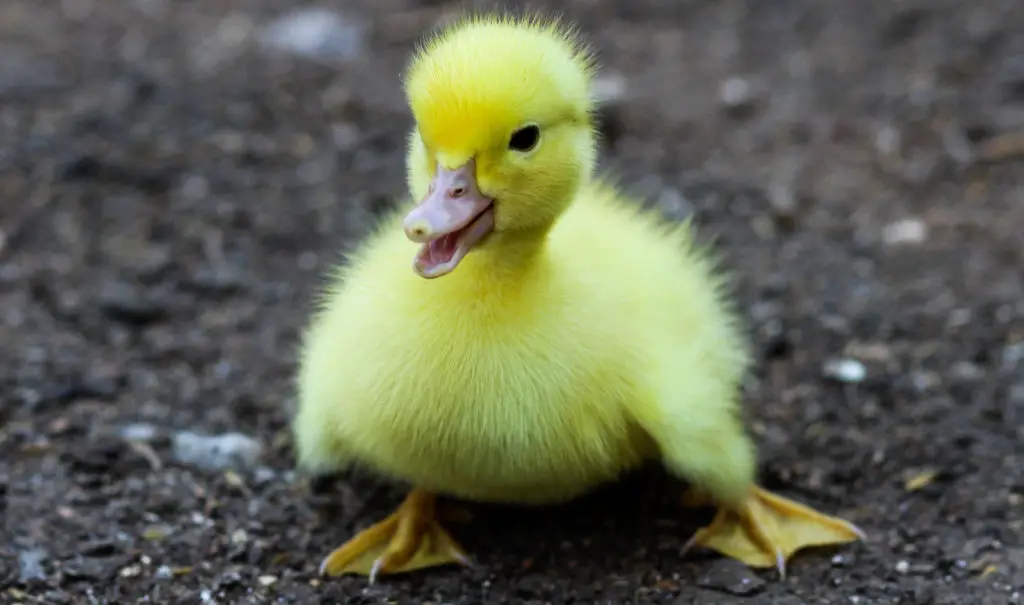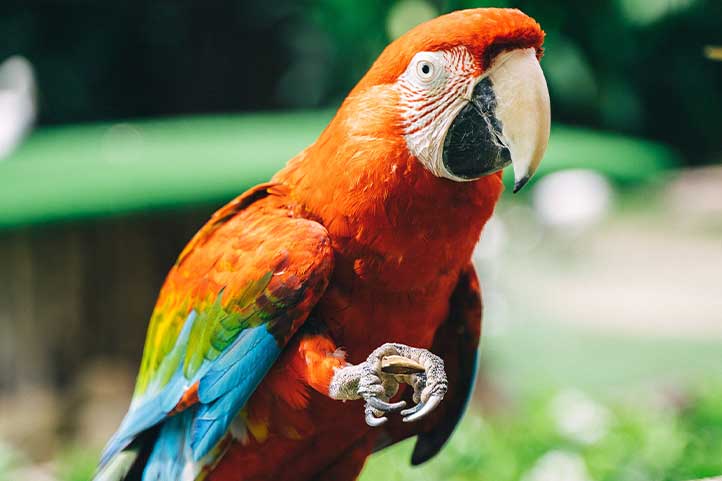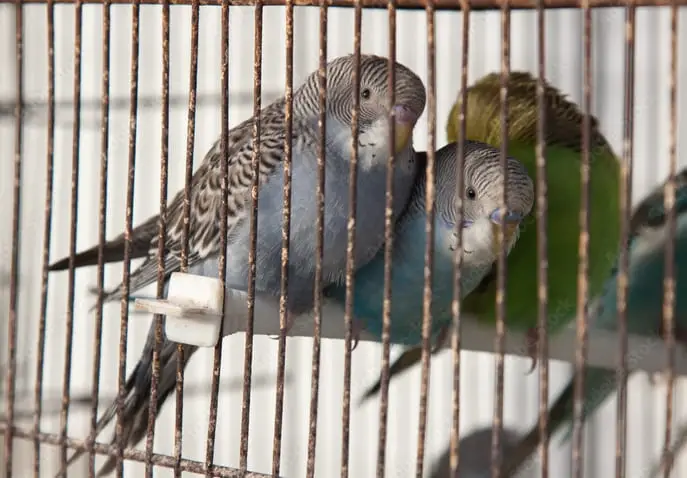Translated by Nick R
Ducks are fabulous birds very close to humans yet we often have little understanding of them. Ducks have become good pets, and many people wish to have more of these animals and raise ducks. Would you like to learn how to do it?
Table of Contents
About ducks and their babies
The duck (genus Anas) is a group of waterfowl widely domesticated worldwide for different purposes, either for poultry production for its meat and eggs or, as poultry. In this case, we are only interested in them as pets. Ducks group several species sharing several physical and ethological (behavioral) characteristics, among them, their great ability to swim. Some of their main characteristics are:
- Ducks are oviparous, that is, they lay eggs.
- They have flat feet, useful for swimming. In addition, they have very strong toes with no blood supply or nerve endings, so they feel no pain or cold.
- The beak has an elongated spatula shape very characteristic of ducks.
The vast majority of breeds are descended from the mallard or mallard duck, originally known as the wild duck.
Reproduction of ducks
The duck is a monomorphic bird species, meaning that both females and males are morphologically identical, except for their cloacae, which differ from one sex to the other, as there is a protuberance in males.
Most ducks are seasonal monogamous birds, which means that they are faithful for a while and remain with the same partner during the breeding of ducklings. They then separate and look for another mate each year, becoming polygamous birds in the end.
Despite being monomorphic, male ducks may show marked differences during the reproduction and breeding season, both in plumage and beak, revealing more vivid and showy colors, as well as a more erectile tail pointing upwards. Breeding takes place after courtship. The courtship is based on a parade of the males, who walk proudly past the females, showing off their plumage.
Finally, mating takes place on land or on the water. The domestic duck, for example, prefers the water as it is a much more fertile environment. Mating lasts one or two weeks until the female is fertilized.
In its natural habitat, a duck seeks a dry place to nest and doesn’t let any other duck near it. Then, it builds and buries the nest in the shape of a gravy boat on the ground in a dark, safe place.
The 5 best duck species to breed
There are several breeds of ducks, but not all of them are ideal for domestication or breeding as pets. The five best duck breeds to raise from babies are:
Pekin duck
This is one of the most sociable, affectionate, and calm duck breeds, making it an excellent choice, especially when you are a beginner or if you have children. This bird is characterized by its completely white plumage, with very colorful orange legs and beaks. It has a prominent chest and grows very fast. As for food, it is a very economical pet since it consumes little food compared to other breeds.
Mallard duck
This duck breed is native to France and has been bred for a long time as a pet because of its exotic colors. They are docile and calm birds, which makes them easy to breed. They are also excellent fliers unlike other breeds, so you should offer plenty of space. It is a bird with colorful and bright plumage: its head is green, it has a brown chest, a color that extends in the form of stripes on the back; while its wings are gray with some brown stripes.
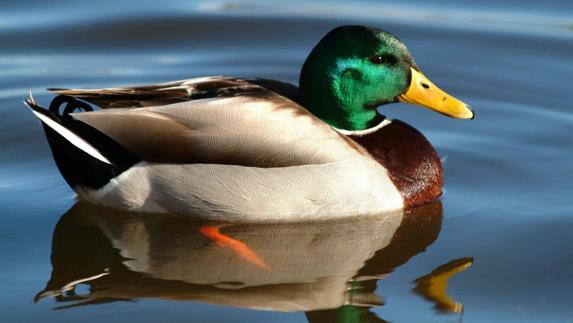
Domestic duck
The domestic duck is a large breed characterized by its docility and sociability. It’s very similar to the Peking duck due to its white plumage and yellowish legs. However, it is distinguished by its carriage and horizontal orientation of the body. In addition, its beak is pink and its plumage is white with light-reflecting silver. Another of its most evident characteristics is its loud quacking.
Cayuga duck
It is one of the most recommended breeds for children due to its calm, friendly, and very docile behavior. It’s also a very strong bird, capable of adapting to any environment and climate. It’s characterized by a black plumage with iridescent green highlights, a black beak, and legs. It’s also a robust bird with round breasts. Not such a bulbous bird, so you can usually find it in residential and suburban areas.
Mute duck
The mute duck is the only species that doesn’t descend from the wild duck, although it has two subspecies: one wild and one domestic. In this case, the recommended subspecies, obviously, is the domestic variation Cairina moschata domestica, which is very affable and calm. It’s a subspecies that has lost the ability to fly long distances, heavier, and characterized by a plumage of varied colors and less bright (white, black and brown).
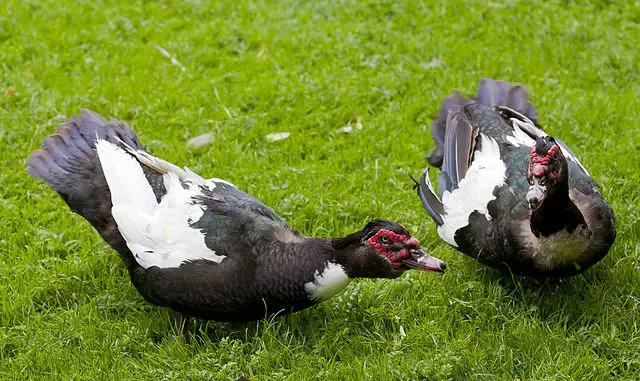
The “Mule duck”
The mule duck arises from the cross between the mute duck and the Peking duck. This hybridization has become very common in households but is not highly recommended for breeding because it is infertile.
Growth stages
Ducks have three different growth stages in their life cycle, which are determined by their sexual maturity. The duckling grows into a sexually developed adult duck.
Chick
The duckling is still a chick until the first 6 or 7 weeks, at which age it’s very fragile and requires a lot of care and constant vigilance, both from the mother and the owner (you). At this point, the plumage barely grows and the chick is not able to leave the nest alone. If it were released before this age, it would die for sure.
Young
Youth begins after the 7th or 8th week (almost two months) when ducks can become independent of their mother, fly on their own and feed themselves with adult food (feed). The plumage is a very evident indicator since a more uniform plumage covering the whole body can be noticed.
Adult
Ducks reach sexual maturity between 6 and 10 months on average, although some species are not ready to breed until they are 14 months old, as is the case with the mallard duck (Mallard). Males begin to have noticeable physical changes, while females do not. The bird breeds and the same cycle repeats itself.
Why should you raise ducks?
Ducks are excellent birds to have at home due to the species’ own characteristics, which make them an ideal pets for owners with country homes. Here are five advantages:
- A bird species that will literally not starve to death, as ducks are omnivores and adapt to varied diets with great ease.
- Ducks are very strong and don’t require a vaccination plan like other birds, except for the vaccine against parvovirus.
- They are very calm and sociable birds, very good with children. Actually, it will be very easy to tame them.
- They are independent animals, requiring only basic care.
- They are very intelligent birds, able to follow instructions easily. In fact, unlike chickens, you should not chase them, but rather, you can organize them like cattle.
How to feed ducks during the breeding season?
The feeding of the parents is as important as the feeding of their chicks; incubation depends fundamentally on how well-fed the parents are, which will produce their chicks with a great energetic effort. If the parents are not well fed and have not been properly cared for, you could get very weak broods.
Since ducks are omnivores, they can eat anything. In general, the diet of ducks is based on feed, a food composed of a robust mixture of seeds and grains with the basic nutrients for a healthy diet. This diet is supplemented with fruits and vegetables. NEVER feed bread to your adult ducks or babies.
But what should they eat during the breeding season?
At this time, you must supplement the parent’s diet with additional protein sources, fruits and vegetables, as well as insects or fish (depending on the species). You can choose to buy or prepare a breeding paste with eggs, eggshells, and unsweetened bread and add a fruit or vegetable, a superpower parent mix. The mixture will greatly help the female, which has to lay and incubate the eggs, a great expenditure of energy.
How to raise baby ducks?
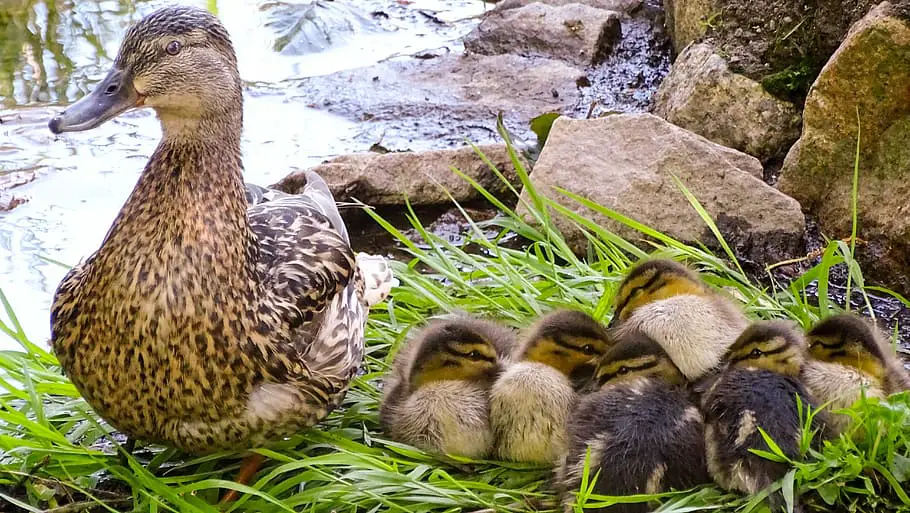
Basic care of baby ducks
The ducklings are very susceptible to diseases in the first 6 weeks, a time when they are most vulnerable and dependent. Baby ducks require special space and food to survive the most beautiful and delicate time of their lives.
Ideal environment
Adult ducks love the outdoors and prefer places with plenty of space, including ponds or water bodies to swim and refresh themselves.
However, when it comes to the babies, the area needs to be more secure than spacious, so that the duck can safeguard the life of her baby and together with you, better supervise the chick as it grows. In this sense, the best option is to have a nest in an enclosed space (try not to make it too small), shared only by the mother and her ducklings. You can start with an incubator box and then, adapt a small brooding cage.
Adequate feeding
Duck chicks require a diet that provides them with enough nutrients to grow strong and healthy, excluding the first 3 days or 72 hours of life, when you must not feed them. After this time, provide plenty of water as a matter of urgency. Many people recommend feeding adult food from a young age in small portions. But, in reality, it is NOT very advisable because the digestive system of the chick is not yet adapted and it could harm it.
Add chicken feed (also called chicken grower) to the water and combine it with another source of fiber and protein (15 – 20%), a source of calcium, vitamins (if it contains B3 better) and water. Hydration in ducks is critical, so water should always be available for their drinkers.
Raising ducks from babies
Hatching
As well as space and food, for raising healthy and happy ducks from babies you must take into account each of the steps in the bird’s maturation process, from duckling to adult duck. How to take care of the chicks before hatching?
Incubation is the method by which the ducklings (not the males because they leave and rejoin other males), ensure the gestation of their chicks; since without the warmth of their mother, the embryo cannot develop. The incubation of a duckling lasts an average of 28 days (taking the domestic duck as a reference).
After the gestation period, when the eggs are about to hatch, you can help the new generation by opening a small hole in the shell to make it easier to hatch (only for experts). You can tell when the chick is about to hatch by holding the egg up and backlighting it. Remember, you must create an incubator box and introduce it there after a few hours of hatching, while it recognizes the surrounding environment, since ducks hatch and can almost immediately walk and swim.
The nest inside the incubator box has to have feathers or shavings on the bottom, never paper or plastic (they can get hurt). Then, install a light bulb as a heat source at a prudent distance (supervise constantly). While the mother incubates the eggs, the temperature should not be lower than 35°C (95°F). In fact, if you can keep it above 36°C, so much the better. It is very important that the chicks remain close to their mother at all times so that she can regulate the temperature accordingly.
First weeks
Each stage of growth is important and has its own particularities, so you need to pay close attention to the following instructions for caring for the chicks after hatching.
During the first weeks, when it is still a chick, provide it with sufficient warmth and protect it from drafts. Both low temperatures and “ill-intentioned” winds are the worst enemies of a duck chick. The temperature should be regulated and lowered a little more than 36°C, at about 34 or 35°C it will be fine.
Feeding during the first weeks is fundamental for the proper growth of the chick, but also to avoid diseases such as “angel wings” that cause atrophy of the wings. To keep it healthy and strong, you can buy special food for baby ducks with an additional amount of vitamin B (niacin) or, prepare homemade food or duck porridge, from a set of ingredients that will provide it with the necessary nutrients in its first stage of life.
How to prepare baby duck food at home?
Follow the step-by-step below to prepare baby duck food:
- Get two containers and the ingredients ready.
- Boil an egg and keep its shell.
- Add the chicken feed.
- Add a small amount of ground eggshell (it should be a fine powder).
- Moisten the feed with water until the paste is formed.
- Add oatmeal as a source of fiber (optional).
- Add alfalfa leaves (optional).
A duckling is like a human baby, every little thing you do for its well-being counts. Take care of it as if it were your own!
You may also be interested in
